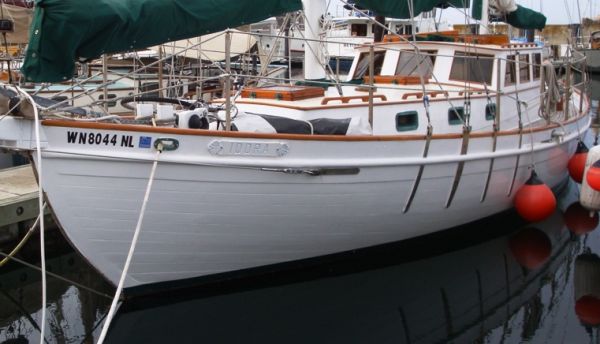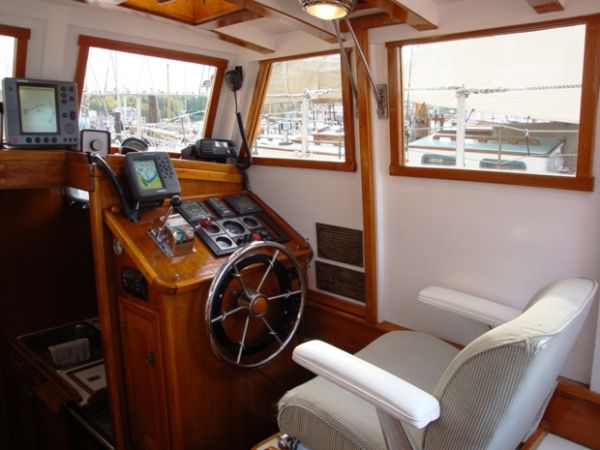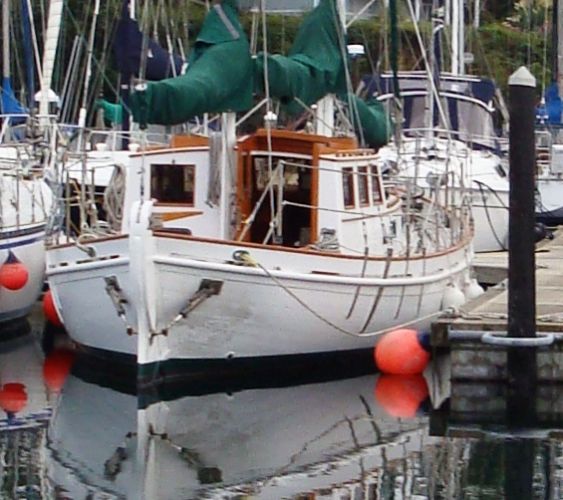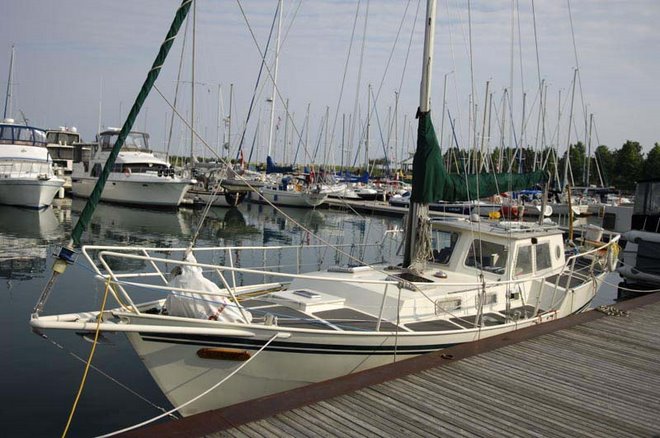
There is a lot of chatter of late in that small portion of the "online cruising community" to which I am exposed. Unsurprisingly, it's all about the world economic D-word and how it is affecting upcoming cruising plans. For those who were counting on steadily accumulating retirement plans and stock portfolios to finance an endless summer bobbing about in the Caribbean, things must be looking squally indeed.
For myself, our retirement fund is entirely separate from the calculations we've made in order to test the feasibility of five to six years of world cruising. Our decision currently is to defray paying down the mortgage of the house we intend to rent out while gone (thus reducing the cruising kitty), primarily because our variable rate has dropped to under 2%. Let the tenants pay it, is the current thinking.
We want only for the house to pay for itself in rent, and to cover the property taxes, the insurance and the utilities. We don't require "a skim" for cruising, although such a cushion would be of course welcome, particularly if it covered expensive recurring items like medical coverage or a major failure like "replace motor".
I'm Canadian and I seriously expect our dollar to leap about 40 cents U.S. in value when the world realizes the U.S. is printing its way to "recovery", which I interpret as "10 years of stagflation until all the crap debts are dealt with". I have a nearly 30 year record of self-directed investing (I started with a "stock club" in high school) and have a reasonable confidence in keeping our finances in order in the coming years.
Having said that, we have two adults and one child proposing a five-year circ on a paid-for boat with about $20,000 in further services I can't do, or can't do well enough for the open ocean (like welding) and in gear (like RADAR, solar panels and batteries) to install or to retrofit before we go in 2011. In other words, I am committed to a fairly high "pre-spend" in order to just get off the dock.
I expect that we will spend approximately $25K/year (assume Canadian/American money at par here), of which $6,000-$8,000 will be fuel and maintenance. This may seem low, but such rather simple expedients of anchoring out consistently, the fact that a great deal of the boat's systems will be new (sea-tested, for we plan a trial trip to the Maritimes) or personally refurbished and simplified. Add to that a willingness to use the sails as much as possible (and carrying the means to repair and extend them) can save a great deal of money from the more typical cruiser budget.
I advocate reading "The Voyager's Handbook" by Beth Leonard here, because a number of spending scenarios in this book convinced me I wasn't radically off in my thinking.
We may return only once in five years back to Canada. Not flying back and not having the cost of decommissioning and storing the boat on land is a great saving. We do anticipate one "prime and paint" haulout, likely in New Zealand, that might take a season in a yard.
As noted above, we will be renting out the house (two two-storey "flats", maybe $2,500 in and $500-$650 out in insurance, utilities, land taxes and "other" monthly) and we will be paying either my sister or one of my wife's brothers (he's a superintendent) to be "the face in the place" in order to collect rent, to do light maintenance and to handle the bills.
Again, unlike some, we aren't relying on tenants for the cruising kitty. We are wanting them to cover the mortgage ($1,200/month). I will likely work while we are gone (I'm a writer and graphic designer) and expect to make maybe 18 months of the 5 x $25K worth of expediture while in transit. I'm setting that aspect of things up now.
I also expect to lower costs by doing some fabrication and fixing for other cruisers, as I will have a small workshop aboard that will carry the sort of tools I need for a steel boat (plus the means to power them), but aren't always practical to carry on a Beneteau, for instance. I suspect many of these sort of transactions will be "in kind", but that's fine: If I'm handed a case of 24 cans of top-end stew and a bottle of rum for two hours of putting in custom-cut backing plates or for beefing up an anchor roller or for stitching together a mainsail split, that's a good cruising day for me and for my crew.
I look long and hard at various cruising narratives and blogs, and even if I assume 25% of the stories told are either lies or prettied up beyond recognition, I don't think my numbers nor my game plan are particularly unrealistic. The fact is that a lot of people go cruising who are perhaps too old for it, too unskilled/self-reliant for it, too reliant on technological aspects of it, and who have a great fondness for "amenities". I don't think this is a harsh assessment, just one that acknowledges how pervasive "condo thinking" is among those who would sail the seven seas, and end up motoring between Caribbean marinas with the Jimmy Buffett and the air conditioning at full blast.
Us, not so much. With me at 50 in 2011, and with a 37 year old wife and a 10 year old kid, we'll be relatively youthful in the cruising community, yet not suspiciously so! I expect opportunities to cut costs via small jobs will be available, and as I come from a marketing background, I know how to ask.
While we plan on working very much on an ad-hoc basis, the element of barter would tend to keep things friendly. We are also willing to trade skills, like "we'll scrape the crap off your hull if you repair our head" (some people would consider this a good trade!). An approach we've considered is announcing on cruiser nets that we are available for "consultation" before we arrive, but this obviously skirts the prohibition on commercial activities. Another tack is to list skills on boat cards...along with issuing really nice boat cards. Word will likely get out.
If it doesn't, it's not critical. As I said, ad hoc. One idea I had was anchor recycling: In some popular anchorages, it is likely that there are unbuoyed, snagged or otherwise abandoned anchors on the seabed that might be retrievable by diving on them. Get the kid to chip off the barnacles, replace a couple of clevis or cotter pins, and sell 'em to other cruisers at cut-rate. Or trade them for diesel, or crates of beer.
You see where this thinking leads: one key to cruising economically is to extract oneself from the money economy in the first place. This can mean getting creative with stores, buying supplies when and where you find them cheaply, and getting used to trading with the locals.
It also helps to like fish. A lot. I do.
The bartering with other cruisers is one thing, but I expect to be bartering with the "natives" as we plan to go a little off the beaten track in the Pacific and Indian Oceans. One of the reasons to carry a Honda genset is that I can drill holes all day in concrete or wood with my 1/2" chuck Makita because I've brought my own power....power being the missing or highly restricted element in some distant anchorages. I figure that's good for a couple of pig roasts and a guided tour to the weird limestone caves if I throw in a box of pencils and a few novelty T-shirts.
That may sound condescending; it's not meant to be. I am citing it as an example of cheap and common items I can carry in bulk that may translate to trade goods in certain places. A waiter at my boat club came to Canada from Cuba 3 1/2 years ago and said just last week that the plan I got from a now-dead cruiser (Diane Stuemer of
Northern Magic fame) to bring lots of kids' T-shirts to Cuba was still a great way to make friends and meet people...because Cubans have difficulty getting T-shirts. Who wouldn't want to help out with that?
My point is that simple trade activity can supply simple items that are not necessarily in ready supply in all places without seeming to be either exploitive, akin to a bribe, or an "in your face, Third World!" move, none of which are liable to make for a happy anchorage. Obviously, I can pay for stuff on passage, but if the point is to see the people of other countries, and not just while they are working for peanuts in Western-style marinas, then I think some effort should be made to engage them in a way that offers them some incentive to treat you more as a human being and not as a transient profit centre.
I think the money economy of the West is largely a mistake in places where people basically work at subsistence levels of growing crops in plots and fishing the sea....and where there are few shops and maybe a ship once every three months. So I would much prefer to barter service for local goods, or for local service. This way, I avoid the money element as much as possible, and yet arguably do something of value that is valuable immediately and in context. If I have the only circular saw or bending jig or spare tarp grommets within 100 NM, I can do more good than slipping the village headman an American 20 dollar bill so I can drink kava with the boys.
My wife's a biologist with some medical training. That should translate well, too. While she's not a doctor, she can set bones and stitch and do a fair number of medical duties...including recognizing when the pros need to be summoned. That's probably welcome in many places.



 As the idea developed, I indicated to Greg that I wanted each panel slightly cambered or tilted to compensate for the fact that boats are frequently heeled. In addition, a panel slightly angled off dead flat will get more photons in the early morning and the later afternoon in some boat positions, and will shed water more easily. The wiring will see Panels 1 and 2 wired together into a device known as an MPPT (which alters the voltage and current to the optimal preset point for charging batteries), and Panels 3 and 4 likewise generating juice on a separate circuit.
As the idea developed, I indicated to Greg that I wanted each panel slightly cambered or tilted to compensate for the fact that boats are frequently heeled. In addition, a panel slightly angled off dead flat will get more photons in the early morning and the later afternoon in some boat positions, and will shed water more easily. The wiring will see Panels 1 and 2 wired together into a device known as an MPPT (which alters the voltage and current to the optimal preset point for charging batteries), and Panels 3 and 4 likewise generating juice on a separate circuit.












